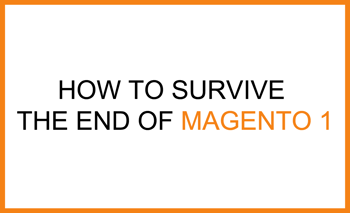
 How will you handle Magento 1 end of life?
How will you handle Magento 1 end of life?Magento has announced the end of support for Commerce versions 1.9 through 1.14 and Open Source versions 1.5 through 1.9. Support will end in June of 2020 and while that may seem like ages from now, you need to start preparing for this eventuality sooner rather than later.
Here are the official details from Magento concerning support through June 2020:
We all know that best practice says to run the most recent release of a software, but upgrading your Magento site doesn’t happen with just the flick of a switch. That’s why Magento has extended their support commitments; not to keep you complacent, but to encourage everyone running Magento 1 to make the move to Magento 2 with adequate time to get the job done.
Keep in mind that these support commitments only apply to Magento software and not any extensions or customizations you may be leveraging. Be sure to check on the support timeline for your extensions and keep those details in mind when planning your upgrade.
PHP ended support for PHP 5.6 at the end of 2018 and Magento released a patch for Magento 1 users that provides compatibility with PHP 7.2. Magento 2.3 is compatible with PHP 7.2, taking care of one of the details for upgrading from Magento 1 directly to the most recent version, Magento 2.3.
If, for some reason, your organization decides to stay on Magento 1 after June 2020, you will be using an unsupported version of Magento and your site will not be PCI compliant. Additionally, the lack of support will leave your site vulnerable to security risks. Those reasons alone are good encouragement to move to Magento 2.
What if you begin your upgrade to Magento 2, but delays push your go-live date past the end of support for Magento 1? Keep these tips from the Magento Software Support Commitments FAQ:
The best thing to do for your Magento 1 environment at this point is to begin preparing for an upgrade to Magento 2. Of course, Magento 2 has more going for it than just being a supported software. Upgrading to the latest Magento has to offer includes native platform enhancements, improved extensions, enhanced speed and security, and more.
With over a year left before support ends for Magento 1, you have the time to do this upgrade right. Here are our suggestions for starting your upgrade to Magento 2.
Your Magento site’s foundation rests on your customer personas. Personas take real information from your current or desired customers and forms an identity around those demographics. These generalized representations of your ideal customers help make sure that all site development decisions are made with your end user in mind.
Defining who your customers are (or who you want them to be) and what they want from an eCommerce experience will help you figure out how to sell to them. Using your personas, you can design and implement your Magento 2 site in a way that is beneficial for your desired audience. Your personas will help you better figure out if you’re reaching your audience in an effective way to get them convert from visitors to customers.
The good news is that you most likely already have the information you need to create customer personas. For example, you probably already know the approximate age of your average customer and what they’re looking for when they come to your site. You just need to take that information a step further and use it to shape a well-rounded picture of who your customers are.
Now that you know who your ideal customers are, you need to figure out what you want them to do when they get to your site. In the eCommerce world, your customer’s actions are referred to as transactions. But a transaction isn’t necessarily a purchase; it’s simply what you’re considering a successful interaction with your customer or site visitor. By defining your metrics for success, you can better navigate how to facilitate those transactions.
Most eCommerce sites have both primary and secondary transactions. A primary transaction is the main goal for the site and a secondary transaction is often an interaction on the path towards a primary transaction. For most eCommerce sites, the main goal is making a sale. So, if your primary transaction is making a sale, what does a secondary transaction look like? In that case, a secondary transaction might be something that nudges a site visitor towards becoming a customer, like signing up for emails or adding an item to a wish list.
Believe it or not, making a sale isn’t always the ultimate goal of an eCommerce site. We have clients whose main goals are to drive brand recognition. In those cases, the primary transaction is when a site visitor viewed a page that gave them more information about the product, and a secondary transaction was making a sale.
We've had other clients whose customers were, primarily, an older crowd, skeptical of making purchases online. For them, a primary transaction was a site visitor signing up to receive paper catalogs in the mail. Someone receiving a catalog is making purchases, just not necessarily on their eCommerce site.
Identifying your primary and secondary transactions will help you better understand how your organization is defining success for your Magento site. And not only can success look different for every organization, you can have more than one definition as well. We often find that our customers have three to five primary transactions and about ten secondary transactions.
So, you know who you want your customers to be and what you want them to do; how are you going to get them to do those things? Knowing what features your site needs to get your customers to accomplish the desired transactions will define the development of your Magento site.
With your audience in mind, what Magento features, functionality, and marketing programs are going to resonate with your customers and help you accomplish your goals?
After looking at their site activity, one of our clients found that their customers love a good deal. Whether that’s a price cut or a free gift with purchase, their customers were jumping on a bargain whenever one presented itself. So, they knew they needed the ability to easily adjust pricing and promote daily sales on their eCommerce site, both of which Magento offers. They are also able to run email campaigns alerting their customers of upcoming deals through Magento’s marketing tools.
For another one of our clients, they knew that having big names advertising their product onsite would resonate with their customers. So, they had some of the most recognizable names in their industry endorse their product through high-quality images and videos. Additionally, they included detailed product descriptions and imagery to educate their customers on their products.
For anyone who has implemented a new eCommerce site before, these foundational items shouldn’t come as a surprise. Having established personas and well-defined success metrics along with identifying what features, functionality, and content you need to implement are fundamental items to have in place when making changes to your eCommerce site. All of that preparation when paired with a well-designed, easy-to-use Magento 2 environment will build a rock solid foundation on which to expand your eCommerce site to more elaborate, flashier features.
So, are you ready to upgrade from Magento 1 to Magento 2? Now is the time to start to ensure you have everything in place before end of support for Magento 1. Our team is experienced in Magento 1 to Magento 2 upgrades. Contact our experienced team to get started on your project.
Lorem ipsum dolor sit amet, consectetur adipiscing elit

For the past two decades, we've made it our business to help you work smarter. From commerce challenges to ERP customizations, we support the power of your big ideas by helping you work more strategically, more intuitively, and more efficiently.
2658 Scranton Road, Suite 3
Cleveland, Ohio 44113
216.369.3600
No Comments Yet
Let us know what you think